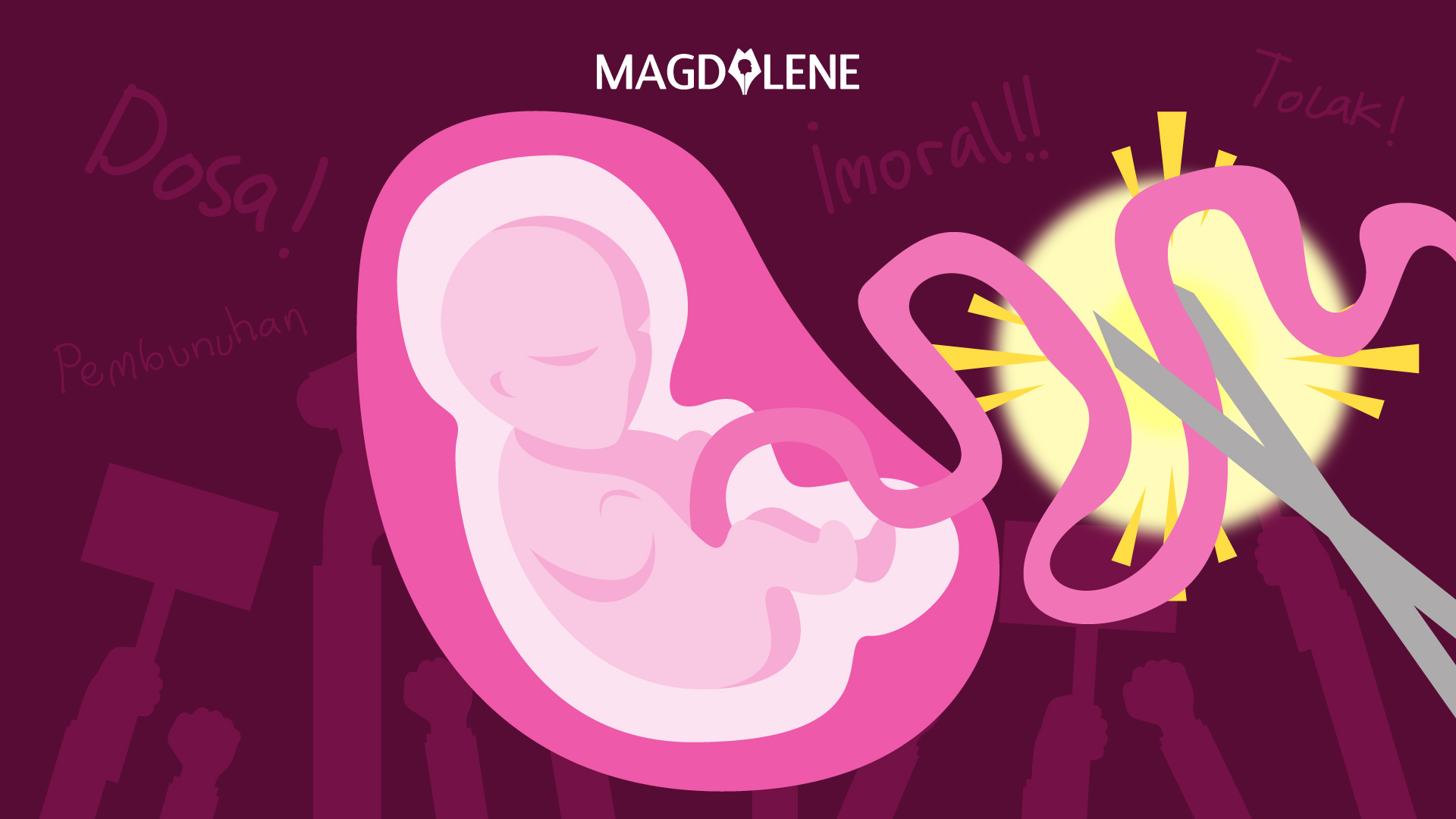In mid 2019, I was editing a review on the movie Dua Garis Biru, which tells the story of teen pregnancy. I hadn’t seen the movie then, but after editing piece, which was written by the daughter of a good friend, I was disappointed with the ending of the movie. Prior to this, I had come across an article on a 1988 edition of famous women’s magazine titled “Anak Gadisku Hamil, Digugurkan atau Diteruskan?” (My Young Daughter is Pregnant; Should We Abort or Continue the Pregnancy?), which had a completely different ending than the movie.
A few months later, I finally had a chance to watch the movie during a film festival. Leaving the cinema I had so many questions, especially why the movie didn’t choose another ending of Dara getting an abortion instead of keeping the pregnancy to term.
I was 29 years old when I thought that I might be pregnant. All the three pregnancy tests I took three days in a row in early September showed 2012 positive results. I confided in a good friend, who was like a sister to me, on what I should do about my pregnancy. I didn’t want to keep the baby, but my situation also didn’t fall into any medical emergencies that enabled me to get an abortion legally. The Indonesian Law No. 36/2009 on Health allows abortion if a pregnancy poses a threat to a woman’s health and life, in cases of fetal impairment, or if the pregnancy was the result of rape with up to 40 days gestation.
She mention a rights-based organization that supports access to safe abortion and I called the hotline to find out the available options for me. The counsellor told me to get an ultrasound before we could proceed to the next step. The same counsellor also told me which hospital was friendly to unmarried women accessing the service.
Also Read: Facts About The Supreme Court Abortion
The ultrasound showed that I was four-weeks pregnant and, subsequently, my counsellor informed me that the medical abortion using Misoprostol would be sufficient to terminate the pregnancy. I was to take 12 pills of Misoprostol, 200 mcg each, in three different times. I followed the instruction and was prepared for the side effects that might include contractions and vaginal bleeding. I experienced nothing but a light diarrhea. My counselor told me to wait another 12-24 hours to see the effect, still, nothing happened. I had to find another solution.
At the time, my ex-boyfriend had moved to Hanoi, Vietnam, for work. He was aware of my pregnancy and said he would be willing to provide for the child if I decided to keep it. I told him I was going terminate the pregnancy even if he offered to marry me. Unwanted pregnancy is never the right reason to get married.
After my failed abortion, we decided that I could get access to safe abortion in Hanoi, and some research showed that French Hospital in the city offers abortion for unmarried people.
Within two weeks, I flew to Hanoi to see a doctor. Another ultrasound confirmed that I was six-weeks pregnant and the doctor suggested that I had another medical abortion, rather than a surgical abortion. Though still skeptical after my previous failed attempt, I agreed to it. At the least I was getting treatment from a professional health provider.
He prescribed me one Mifepristone (by the brand Mifestad 200) to be taken at 7 AM on October 6, 2012. Then, he required me to go back to the hospital the next day at 07.30 AM. I carefully read the brochure for indication and precautions. But I didn’t experience any pain or bleeding at all. I was even able to go walking for hours and did some other activities. On Monday, the nurse gave me 800 mcg of Cytotec (four tablets): two tablets for the first time, and another two after one hour.
I started having painful abdominal cramps and menstrual-like bleeding after the first dose, which remained after the second dose. I stayed the hospital until lunchtime and had an appointment to see a senior nurse at 1 PM. After an ultrasound she prescribed me with four Cytotec to be taken, of which one to be taken at every 8 hours. I was to revisit the hospital in two weeks. I was bleeding for the next three days but I felt all right. It was not painful, so I had no need to take any painkillers. When I returned to the hospital two weeks later the doctor confirmed that my pregnancy had been terminated.
I have since learned that medical abortion with Mifepristone and Misoprostol (Cytotec) done in the first trimester is proven to be 98% effective.
If only Dua Garis Biru had a different ending, it might help fight the taboo surrounding abortion. Looking back, I never regret my decision. I had no financial capacities then to provide for a new a life that I would bring into the world. Nor did I want to have any involvement with the father to raise the child until he or she reach adulthood. The last thing I wanted was to bring into the world a child who has to carry the stigma of “hereditary sin” attached to a child born out of wedlock. This is why I think films like Dua Garis Biru could have done better with its ending.
The article I found on the old edition of women’s magazine talked about a woman whose daughter was pregnant in her second year of senior high. The mother and daughter had a conversation in which the latter said she wanted to have an abortion, so she didn’t have to drop out of school. The mother took her to a trusted gynecologist who recommend the girl to see a psychologist while preparing for the procedure. She had to undergo several tests before her abortion was approved. When the procedure was completed, the daughter conveyed her gratitude to her parents, “thank you for accompanying me in this”.
In Dua Garis Biru, the troubled teens tried to deal with unwanted pregnancy on their own. By the time both parents figured out about their situation, they were given only two options: carry the pregnancy to full term and give up the baby for adoption to a childless relative (by Dara’ mother); or get married so the baby would have a father when it was delivered (by Bima’s mother).
Also Read: Not All Is Lost
The latter option might unintentionally justify the harmful practice of child marriage to resolve the problem of adolescent pregnancy. According to Girls Not Brides, Indonesia has the seventh highest absolute number of women married or in a union before the age of 18 in the world at about 1.8 million people. Around 16 percent of girls in Indonesia are married before the age of 18, and 2 percent are married before their 15th birthday. In comparison 5 percent of boys are married before their 18th birthday.
The option presented by Bima’s mother sent a subtle message that her longing for a grandchild triumphed over other options that prioritize Dara’s needs (to finish high school instead of being expelled for pregnancy, and go to university in South Korea). The decision came with a huge cost also: a childbirth complication resulted in the removal of Dara’s uterus. WHO reported that complications arising from pregnancy and childbirth are among the leading causes of death in girls aged 15-19. Dara was saved by the screenwriter who decided that she would only lose her Uterus, instead of her life, in the childbirth.
The 2010 Basic Health Research of the Ministry of Health shows unmet need for contraception and family planning services as the biggest factors affecting abortion rate among sexually active women of reproductive age of 15-49. A successful family planning program results in low abortion rate. In Indonesia, the unmet need reaches 11 percent, while the rate of contraceptive use among women of reproductive age is still at 64 percent.
The thing is, abortion continues to take place regardless of its legal status, resulting in unsafe abortion. The World’s Women 2015: Trends and Statistics shows that nearly all of the estimated 22 million unsafe abortions in 2018 occurred in developing countries. A total of 108 countries with restrictive laws against abortion have more than four times as many unsafe abortions as countries with liberal abortion policies. Countries with restrictive abortion laws also had maternal mortality rates that were three times higher than those with liberal abortion policies (223 versus 77 maternal deaths per 100,000 live births in 2013), the data shows.
Indonesia one the highest maternal mortality rate in ASEAN at around 305 deaths per 100,000 live births, despite its SDGs target to reduce the rate to 70 deaths per 100,000 live births by 2030. Research estimated that 14-16 percent of maternal deaths in Southeast Asia are caused by complications resulted from unsafe abortions.
Every year, millions of women in Indonesia seek abortion, most of which occur outside of the formal healthcare system, including 1.7 million in Java alone in 2018. This number likely reflects the tip of the iceberg, as research on abortion is always difficult and the real number of incidences is higher than reported.
People make mistakes in their lives, but having unplanned children is an irreversible mistake that you have to live with for the rest of your life. Movies like Dua Garis Biru could have been a perfect platform to show that you don’t have to suffer the lifetime consequence of adolescent pregnancy.







Comments